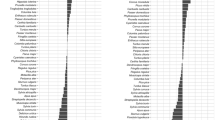Abstract
There appears to be widespread acceptance that for a population to persist, some demographic parameter must be density dependent at some place or time. In this paper, we question the veracity and heuristic value of treating this statement as a general principle of ecology. We also point out that some processes that have recently been defined as density dependent are, in fact, not. Taken in its original sense, density dependence implies a change in demographic rates based on biological (generally negative) feedback. Situations exist, however, in which demographic rates change in relation to density without negative biological feedback. For example, per capita recruitment in marine populations will decrease as local population size increases even as absolute numbers of arriving larvae do not change. The failure to separate these density-related processes from true density-dependent processes affects our understanding of population regulation and of the way in which the natural world functions. Furthermore, focusing solely on density-dependent processes and their role in population regulation neglects to address numerous density-independent processes like disturbance and climatic variation that may have important impacts in determining population size.
Similar content being viewed by others
Author information
Authors and Affiliations
Additional information
Received: 20 January 1999 / Accepted: 12 January 2000
Rights and permissions
About this article
Cite this article
Sale, P., Tolimieri, N. Density dependence at some time and place?. Oecologia 124, 166–171 (2000). https://doi.org/10.1007/s004420050003
Issue Date:
DOI: https://doi.org/10.1007/s004420050003




